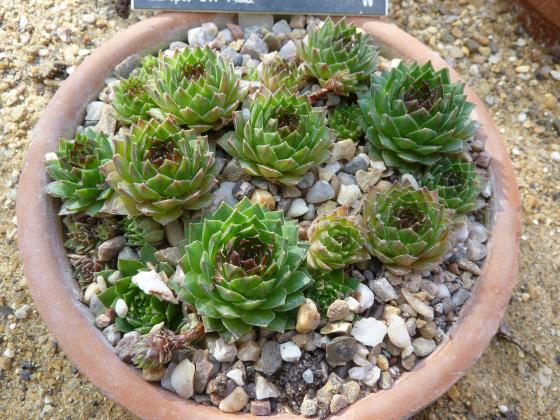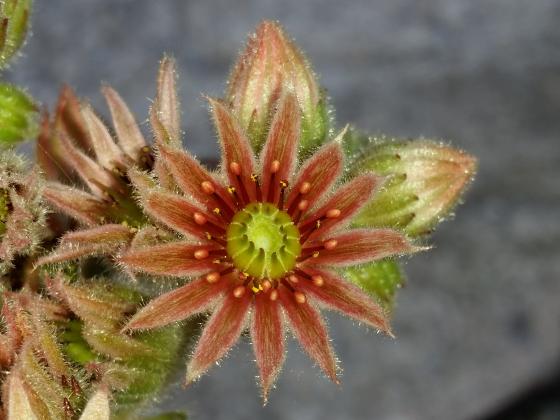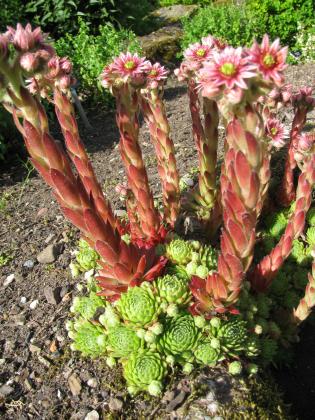Sempervivum tectorum – Planted on roofs for lightning protection
Backyard Horticulture
Sempervivum tectorum, hens and chicks, are evergreen succulents often seen growing in pots or rock gardens. It has been known in many parts of the world for millennia. Leaves, fringed with tiny hairs, spiral around each other and form a rosette, the “hen.” It propagates by forming offsets, buds or “chicks,” which root and become new plants.
Leaves, 3 to 4 inches, vary in color from light green to dark blue green, often with a reddish edge and or tip. The rosette is usually about 6 inches wide. In summer, thick, hairy, flat-topped stems, up to 12 inches high, rise from the plant. The stem ranges from yellow to red. On top there are red to purple hairy flowers that may have white, yellow and or green mixed in. The mother plant dies after flowering.
S. tectorum is mucilaginous with a slightly acid, salty taste. Leaves are eaten raw or juiced in a drink. They are cooling and astringent, so they are used for many skin conditions similar to the way Aloe Vera is used. It’s said to treat pain from a tooth extraction. S. tectorum is in the Food and Drug Administration Poisonous Plant Database at fda.gov.
Sempervivum means “forever alive.” The plant is a resurrection plant appearing dead when dried but coming back to normal when water is added. Living from water reserves in its leaves, S. tectorum can be “dead” up to 18 months, maybe longer, and come back to normal when watered. The species name, tectorum, means “of house roofs.” Sempervivum tectorum, the “forever alive plant of house roofs,” was planted on roofs as lightening and fire protection wherever in the world it was grown. It was believed to have the power to protect against lightening, storms, fire, witchcraft and other evils.
In some parts of the world the plant is known as a houseleek. The word leek is just another name for plant and does not refer to the onion-like allium. So, houseleek means houseplant. For us, houseplant means a plant grown inside a house. But glass windows were not common in homes until the 17th century. With limited indoor light, for most of human history houseplants were grown outside on the windowsill or roof.
Charlemagne (720 - 814), first Holy Roman Emperor, ordered everyone to plant hen and chicks on their roofs as lightening protection. Our roofs are made of non-flammable materials. Our primary heat and cooking source are probably not an open flame. Our heated air, without burning embers, travels through metal ducts. It doesn’t sound like a bad idea for a thatch roof to have fire resistant water-filled succulents that when shriveled by the sun, would come back to normal when it rained. I have seen speculation that the plant disperses positively charged particles that attract lightning’s negative charge. I don’t know whether any of that is true. Even if having a plant or two on the roof is the equivalent of crossing your fingers for luck, it can’t hurt.
Deborah Richardson is a freelance reporter for The Examiner with a fondness for flora in its natural setting.



